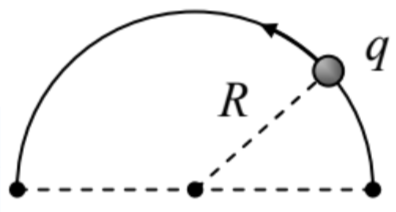10.7: Exercise Problems
( \newcommand{\kernel}{\mathrm{null}\,}\)
10.1. Derive Eqs. (10) from Eqs. (1) by a direct (but careful!) integration.
10.2. Derive the radiation-related parts of Eqs. (19)-(20) from the Liénard-Wiechert potentials (10) by direct differentiation.
10.3. A point charge \ q that had been in a stationary position on a circle of radius \ R, is carried over, along the circle, to the opposite position on the same diameter (see the figure on the right) as fast as only physically possible, and then is kept steady at this new position. Calculate and sketch the time dependence of its electric field E at the center of the circle.

10.4. Express the total power of electromagnetic radiation by a relativistic particle with electric charge \ q and rest mass \ m, moving with velocity u, via the external Lorentz force F exerted on the particle.
10.5. A relativistic particle with the rest mass \ m and electric charge \ q, initially at rest, is accelerated by a constant force F until it reaches a certain velocity \ u, and then moves by inertia. Calculate the total energy radiated during the acceleration.
10.6. Calculate
(i) the instantaneous power, and
(ii) the power spectrum
of the radiation emitted, into a unit solid angle, by a relativistic particle with charge \ q, performing 1D harmonic oscillations with frequency \ \omega_{0} and displacement amplitude \ a.
10.7. Analyze the polarization and the spectral contents of the synchrotron radiation propagating in the direction perpendicular to the particle’s rotation plane. How do the results change if not one, but \ N>1 similar particles move around the circle, at equal angular distances?
10.8. Calculate and analyze the time dependence of the energy of a charged relativistic particle performing synchrotron motion in a constant and uniform magnetic field B, and hence emitting the synchrotron radiation. Qualitatively, what is the particle’s trajectory?
Hint: You may assume that the energy loss is relatively slow \ \left(-d \delta / d t<<\omega_{\mathrm{c}} \theta\right), but should spell out the condition of validity of this assumption.
10.9. Analyze the polarization of the synchrotron radiation propagating within the particle’s rotation plane.
10.10.* The basic quantum theory of radiation shows that the electric dipole radiation by a particle is allowed only if the change of its angular momentum’s magnitude \ L at the transition is of the order of the Planck’s constant \ \hbar.
(i) Estimate the change of \ L of an ultra-relativistic particle due to its emission of a typical single photon of the synchrotron radiation.
(ii) Does quantum mechanics forbid such radiation? If not, why?
10.11. A relativistic particle moves along the z-axis, with velocity \ u_{z}, through an undulator – a system of permanent magnets providing (in the simplest model) a perpendicular magnetic field, whose distribution near the axis is sinusoidal:57
\ \mathbf{B}=\mathbf{n}_{y} B_{0} \cos k_{0} z.
Assuming that the field is so weak that it causes negligible deviations of the particle’s trajectory from the straight line, calculate the angular distribution of the resulting radiation. What condition does the above assumption impose on the system’s parameters?
10.12. Discuss possible effects of the interference of the undulator radiation from different periods of its static field distribution. In particular, calculate the angular positions of the power density maxima.
10.13. An electron launched directly toward a plane surface of a perfect conductor, is instantly absorbed by it at the collision. Calculate the angular distribution and the frequency spectrum of the electromagnetic waves radiated at this collision, if the initial kinetic energy \ T of the particle is much larger than the conductor’s workfunction \ \psi.58 Is your result valid near the conductor’s surface?
10.14. A relativistic particle, with rest mass \ m and electric charge \ q, flies ballistically, with velocity \ u, by an immobile point charge \ q’, with an impact parameter \ b so large that the deviations of its trajectory from the straight line are negligible. Calculate the total energy loss due to the electromagnetic radiation during the passage. Formulate the conditions of validity of your result.
Reference
57 As the Maxwell equation for \ \nabla \times \mathbf{H} shows, such field distribution cannot be created in any non-zero volume of free space. However, it may be created on a line – e.g., on the particle’s trajectory.


